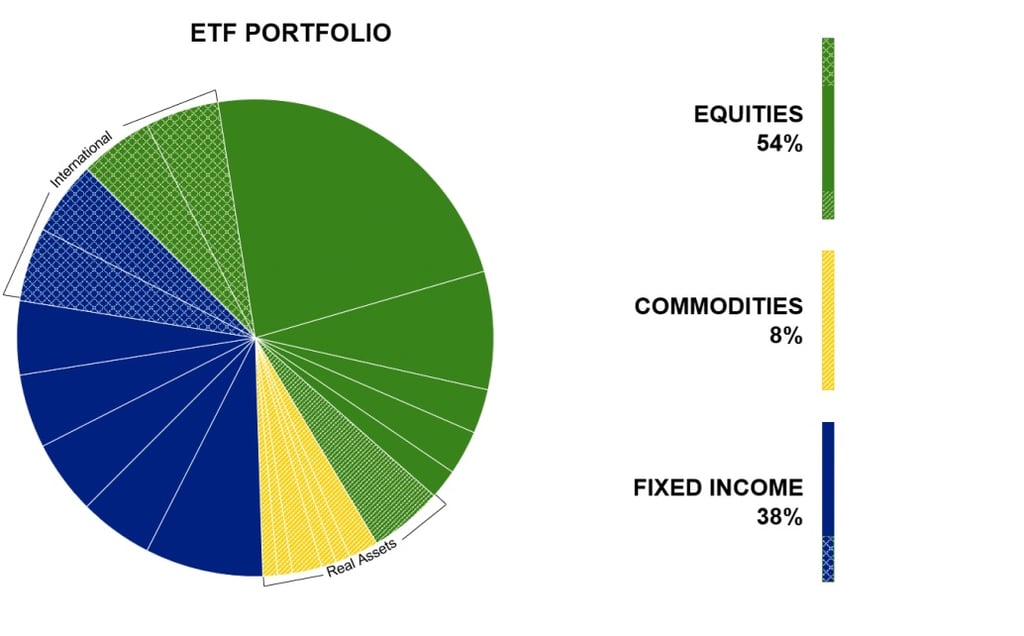How to Build a Diversified Portfolio Using ETFs
ETFs are one of the best ways to build a diversified portfolio with less risk and strong long-term growth. But how do you choose the right mix of ETFs? In this post, discover the four key ETF categories, the best portfolio structures, and the most common investing mistakes to avoid! 🚀
ETF INVESTING FOR BEGINNERS
Christopher Skyler
10/15/20243 min read


The Smartest Way to Invest: Diversification Without the Complexity
If you want to build wealth with less risk, diversification is key. But how do you diversify effectively without spending hours researching individual stocks?
The answer: ETFs.
ETFs (Exchange-Traded Funds) allow you to own a wide range of assets—stocks, bonds, real estate, and even commodities—all in a single investment. This makes them one of the best tools for building a strong, diversified portfolio, whether you’re a beginner or an experienced investor.
In this guide, you’ll learn why diversification matters, how to choose the right ETFs, and how to structure your portfolio for long-term success.
1. Why Diversification Is Essential for Wealth Building
Diversification is the golden rule of investing. Instead of putting all your money into one stock or one industry, you spread your investments across multiple assets.
📌 Why This Matters:
✅ Reduces risk – If one investment performs poorly, others can balance it out.
✅ Smooths out returns – Avoids huge losses from individual stock crashes.
✅ Maximizes opportunities – Gain exposure to multiple growing industries.
Example of a Poorly Diversified Portfolio vs. a Well-Diversified One:
❌ High-Risk Portfolio:
100% in a single stock (e.g., Tesla) → If it crashes, your portfolio suffers.
✅ Well-Diversified Portfolio:
50% in broad-market ETFs 📈
30% in sector-specific ETFs 🏦
10% in bond ETFs 🏛
10% in alternative assets (real estate, commodities) 🏠
With ETFs, you can easily create a diversified portfolio with just a few funds.
2. The Core ETF Categories for a Diversified Portfolio
To build a well-balanced portfolio, you need ETFs that cover different asset classes and regions.
Here are the four key types of ETFs every investor should consider:
Broad Market ETFs – The Foundation of Your Portfolio
💡 Why? These ETFs give you exposure to hundreds or thousands of companies, reducing risk while ensuring steady growth.
✅ Top Choices:
S&P 500 ETFs (SPY, VOO, IVV) – Invests in the 500 largest U.S. companies.
Total Market ETFs (VTI, SCHB) – Covers the entire U.S. stock market.
Global Market ETFs (VT, ACWI) – Diversifies across international markets.
📌 Best for: Long-term, low-risk growth.
Sector & Thematic ETFs – Targeting High-Growth Industries
💡 Why? These ETFs allow you to focus on specific industries that outperform the market.
✅ Top Choices:
Technology ETFs (QQQ, VGT, XLK) – Invest in companies like Apple, Google, and Microsoft.
Healthcare ETFs (VHT, XLV) – Exposure to pharmaceutical and biotech companies.
Clean Energy ETFs (ICLN, TAN) – Focus on renewable energy stocks.
📌 Best for: Investors who want higher growth potential while staying diversified.
Bond & Dividend ETFs – Stability and Passive Income
💡 Why? These ETFs provide steady returns and protection during market downturns.
✅ Top Choices:
Bond ETFs (AGG, BND) – Includes government and corporate bonds for stability.
Dividend ETFs (VYM, SCHD) – Focuses on stocks that pay high dividends.
📌 Best for: Reducing risk and earning passive income.
Real Estate & Commodity ETFs – Alternative Investments
💡 Why? These ETFs give exposure to physical assets that don’t move in sync with stocks.
✅ Top Choices:
Real Estate ETFs (VNQ, SCHH) – Invests in real estate investment trusts (REITs).
Gold & Silver ETFs (GLD, SLV) – Hedge against inflation.
Commodities ETFs (DBC, PDBC) – Includes oil, natural gas, and agricultural products.
📌 Best for: Adding extra diversification and protecting against inflation.
3. How to Structure Your ETF Portfolio (Based on Risk Tolerance)
Your ETF portfolio should match your risk tolerance and investment goals. Here are three sample portfolios for different investor types:
🚀 Growth-Focused Portfolio (High Risk, High Return)
For investors willing to take more risk for higher potential returns.
✅ 60% Broad Market ETFs (S&P 500, Total Market)
✅ 25% High-Growth Sector ETFs (Tech, Healthcare, AI)
✅ 10% International ETFs (Emerging Markets)
✅ 5% Alternative Assets (Crypto, Gold, Real Estate)
📌 Best for: Young investors or those with a long investment horizon.
⚖️ Balanced Portfolio (Moderate Risk, Steady Growth)
For investors who want a mix of growth and stability.
✅ 50% Broad Market ETFs
✅ 20% Sector ETFs (Technology, Healthcare, Energy)
✅ 20% Bond ETFs (Treasuries, Corporate Bonds)
✅ 10% Real Estate ETFs
📌 Best for: Investors looking for consistent growth with moderate risk.
🛡 Conservative Portfolio (Low Risk, Stable Returns)
For investors who prioritize stability and income over high returns.
✅ 40% Bond ETFs
✅ 30% Dividend ETFs
✅ 20% Broad Market ETFs
✅ 10% Commodities (Gold, Silver)
📌 Best for: Retirees or investors who want lower volatility.
4. Common ETF Investing Mistakes to Avoid
Even though ETFs are great for diversification, there are mistakes that can hurt your returns.
🚨 1. Investing in Too Many Overlapping ETFs
❌ If you buy an S&P 500 ETF (VOO) and a Total Market ETF (VTI), you’re doubling up on similar stocks.
✅ Solution: Stick to a few well-chosen ETFs that complement each other.
🚨 2. Ignoring Expense Ratios
❌ Some ETFs charge high fees, eating into your profits over time.
✅ Solution: Choose low-cost ETFs with expense ratios below 0.20%.
🚨 3. Trying to Time the Market
❌ Some investors wait for the "perfect time" to invest, missing out on long-term gains.
✅ Solution: Invest consistently using dollar-cost averaging (DCA).
5. Final Thoughts: Build Your ETF Portfolio Today
ETFs offer one of the easiest and most effective ways to build a diversified portfolio. Whether you’re just starting out or looking to refine your investment strategy, the right ETFs can help you grow wealth while minimizing risk.
🚀 Action Steps to Start Today:
✅ Choose 3-5 ETFs that align with your risk tolerance and goals.
✅ Set up automatic investments to grow your portfolio over time.
✅ Stay consistent—long-term investing wins over market timing.
💡 Want a step-by-step guide to ETF investing?
📖 Get your copy of ETF Investing for Beginnersand start building your wealth today!
© 2025 SkylerPublishing.com. All rights reserved.
